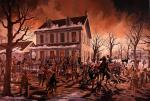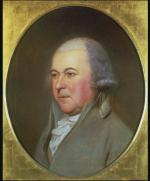![header=[Marker Text] body=[Site of early challenge to federal government's authority. This armed resistance by Pennsylvania-German farmers to the 1798 federal house tax was suppressed by soldiers. Leader John Fries was arrested for treason, condemned to death, and pardoned by President John Adams] sign](kora/files/1/10/1-A-28E-139-ExplorePAHistory-a0h9f6-a_450.jpg)
Mouse over for marker text
Name:
The Fries Rebellion of 1799
Region:
Philadelphia and its Countryside/Lehigh Valley
County:
Bucks
Marker Location:
Main and Broad Sts., Quakertown
Dedication Date:
May 16, 2003
Behind the Marker
On July 9, 1798, a Federalist-controlled Congress voted for a new federal tax on lands and houses, the latter to be assessed by the number of windows. Many Pennsylvanians found the new tax especially obnoxious, for its percentage increased progressively in accordance with assessed value, and many farms in long-settled northeastern Pennsylvania were substantial indeed. The law also said that the tax had to be paid in gold or silver, which was at a premium, and thus cost the taxpayers more than their assessed valuation to obtain.
Congress passed the tax at the same time that the United States was engaged in an undeclared naval war with France, and at a time when the Federalists who controlled Congress viewed domestic opposition to its policies as treason rather than legitimate dissent. In addition, President Adams made the mistake of appointing ex-Tories and Quaker pacifists to collect the tax for northeastern Pennsylvania. The mostly German population of this region had loyally supported the Revolution, and despite their reputation as the "Dumb Dutch" were well aware of their political rights. Protests against the Alien and Sedition Acts, which Congress also passed that June to suppress dissent flowed in from all over the state.
Protests against the Alien and Sedition Acts, which Congress also passed that June to suppress dissent flowed in from all over the state.
By early 1799, loud protests against the tax were gaining momentum in Northampton, Berks, and to a lesser degree Montgomery and Bucks counties. Angry citizens set up Liberty Poles, as they had back in the 1770s in protests against the British taxes that led to the American Revolution. Others poured hot water on the collectors, assaulted them, and destroyed their records. When sheriffs under federal court order arrested twenty-three ringleaders and confined them in the Sun Tavern in Bethlehem, a crowd of more than 100 men led by John Fries of Milford Township in Bucks County, an auctioneer of Welsh descent, marched to Bethlehem and freed them on March 7. The crowd was willing for the twenty-three to be tried, but insisted on trials in the local community, which would have guaranteed a verdict of innocent, rather than Philadelphia, where a guilty verdict was almost certain.
"Fries Rebellion" terrified the Federalists in Philadelphia. Convinced that Fries and his followers had committed treason, President Adams requested that the Philadelphia militia capture them. Led by the light cavalry, a group of wealthy men who paid for their own horses and equipment, the militia moved out, rounded up the leading protestors, and tracked down Fries by following his dog "Whiskey" into a swamp where Fries was hiding.
The federal government charged forty-five of them with treason, then prosecuted Fries and four others for treason and seventeen for lesser crimes. The courts then sentenced Fries and three others to death. President Adams pardoned them, however - against the advice of every member of his cabinet - after he concluded that Fries and his followers were guilty only of "riot and rescue," not of making war on the government with the intent to overthrow it, as his "high" Federalist supporters had suggested.
In the end, President Adams himself was the "rebellion's" big loser. His pardons angered other leading Federalists and fueled their plot to undermine his re-election. And his suppression of the "rebels" - who saw themselves as nothing more than the sort of traditional tax protestors the Pennsylvania legislature had winked at since the 1780s - won him the animosity of the Pennsylvania Germans, who had previously voted Federalist. In the election of 1800, they turned out en masse for the Jeffersonian Republicans and were instrumental in ensuring that the Pennsylvania legislature, which chose Pennsylvania's presidential electors, would be overwhelmingly pro-Jefferson. Had Adams carried Pennsylvania, he would have been re-elected.
Congress passed the tax at the same time that the United States was engaged in an undeclared naval war with France, and at a time when the Federalists who controlled Congress viewed domestic opposition to its policies as treason rather than legitimate dissent. In addition, President Adams made the mistake of appointing ex-Tories and Quaker pacifists to collect the tax for northeastern Pennsylvania. The mostly German population of this region had loyally supported the Revolution, and despite their reputation as the "Dumb Dutch" were well aware of their political rights.
By early 1799, loud protests against the tax were gaining momentum in Northampton, Berks, and to a lesser degree Montgomery and Bucks counties. Angry citizens set up Liberty Poles, as they had back in the 1770s in protests against the British taxes that led to the American Revolution. Others poured hot water on the collectors, assaulted them, and destroyed their records. When sheriffs under federal court order arrested twenty-three ringleaders and confined them in the Sun Tavern in Bethlehem, a crowd of more than 100 men led by John Fries of Milford Township in Bucks County, an auctioneer of Welsh descent, marched to Bethlehem and freed them on March 7. The crowd was willing for the twenty-three to be tried, but insisted on trials in the local community, which would have guaranteed a verdict of innocent, rather than Philadelphia, where a guilty verdict was almost certain.
"Fries Rebellion" terrified the Federalists in Philadelphia. Convinced that Fries and his followers had committed treason, President Adams requested that the Philadelphia militia capture them. Led by the light cavalry, a group of wealthy men who paid for their own horses and equipment, the militia moved out, rounded up the leading protestors, and tracked down Fries by following his dog "Whiskey" into a swamp where Fries was hiding.
The federal government charged forty-five of them with treason, then prosecuted Fries and four others for treason and seventeen for lesser crimes. The courts then sentenced Fries and three others to death. President Adams pardoned them, however - against the advice of every member of his cabinet - after he concluded that Fries and his followers were guilty only of "riot and rescue," not of making war on the government with the intent to overthrow it, as his "high" Federalist supporters had suggested.
In the end, President Adams himself was the "rebellion's" big loser. His pardons angered other leading Federalists and fueled their plot to undermine his re-election. And his suppression of the "rebels" - who saw themselves as nothing more than the sort of traditional tax protestors the Pennsylvania legislature had winked at since the 1780s - won him the animosity of the Pennsylvania Germans, who had previously voted Federalist. In the election of 1800, they turned out en masse for the Jeffersonian Republicans and were instrumental in ensuring that the Pennsylvania legislature, which chose Pennsylvania's presidential electors, would be overwhelmingly pro-Jefferson. Had Adams carried Pennsylvania, he would have been re-elected.







